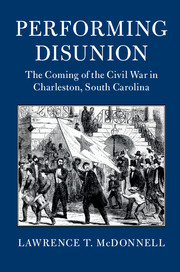13 - Nothing but Cash
from CONTRADICTIONS: STAND NOBLY TOGETHER
Published online by Cambridge University Press: 08 June 2018
Summary
“Revolution!” cried the Mercury; “Revolution!” answered the Courier. In the fall of 1856, Charleston was convulsed by a “Complete Revolution in the Hat Business.” At the center of the storm stood Walter Steele. City born and bred, the thirty- three- year- old merchant had risen through the ranks of clerkship, opened his own store in 1849, and never looked back. “Steele has only to think once, and it is done,” his ad copy marveled. Who could call that claim boasting? Had he not transformed the trade in hats and a host of other goods besides, seizing the lion's share of Charleston's custom? Rallying under the banner of “One Price and No Abatement,” Steele raised a tempest in commercial relations. How he must have laughed to see customers flee the liberal terms of credit other merchants offered, racing for the safe harbor of his King Street “Hat Hall,” where four- dollar beavers sold proudly, on “TERMS – CASH!”
Who could have seen sartorial “revolution” as key to the crisis that brought on civil war? Rather, the mad dash that Steele's ad provoked drew notice for the way it linked the comic and economic, replicating the ridiculous scramble any strong breeze unleashed in the Queen City. There was nothing quite so humorous, men agreed, as the sight of a fellow chasing a windblown hat. Hats had so many meanings – social, sexual, economic, political – that a topper tossed off into the gutter, whirled along with some poor fool tearing after it, seemed irresistibly funny. But schadenfreude was no sort of strategy in finance, politics, or personal life, especially in tight times. Hats aloft and rolling meant honor unhinged, order overthrown, the properly private made rudely public, class unity in doubt. However fleeting, one fellow's fashion crisis acted out broader fears of deeper flaws that threatened to fracture the state: men measured and found wanting. Revolution – in Charleston hats or politics – was an odd thing to celebrate.
Hats of all kinds went flying in South Carolina in the 1850s, ruining some and panicking all. What had raised a wind so sudden and strong? And how could men hope to fight its force, except by clutching wealth, power, status – and the hats that summed them up – doubly tight?
- Type
- Chapter
- Information
- Performing DisunionThe Coming of the Civil War in Charleston, South Carolina, pp. 271 - 283Publisher: Cambridge University PressPrint publication year: 2018

